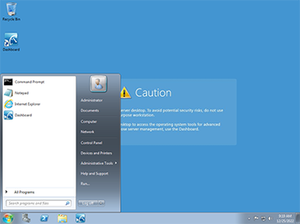Windows Home Server 2011
| A version of the Windows NT operating system | |
 |
|
 |
|
| Developer | Microsoft |
|---|---|
| Source model | Closed source / Shared source |
| Released to manufacturing |
6 April 2011 |
| Update method | Windows Update |
| Platforms | x86-64 |
| Kernel type | Hybrid |
| License | Proprietary commercial software |
| Preceded by | Windows Home Server (2007) |
| Succeeded by | Windows Server Essentials 2012 (2012) |
| Official website | www |
| Support status | |
| Mainstream | Ended on April 12, 2016 |
| Extended | None offered |
Windows Home Server 2011, code named Vail, is a home server operating system by Microsoft designed for small office/home offices and homes with multiple connected PCs to offer protected file storage, file sharing, automated PC backup, remote access, and remote control of PC desktops. It was released on 6 April 2011 following the release of Power Pack 3 for its aging predecessor, Windows Home Server. Windows Home Server 2011 is the last Windows Home Server release and was succeeded by Windows Server 2012 Essentials.
Windows Home Server 2011 is based on Windows Server 2008 R2 and Windows 7 and requires x86-64 CPUs (64-bit), while its predecessor worked on the older IA-32 (32-bit) architecture as well. Coupled with fundamental changes in the structure of the client backups and the shared folders, there is no clear method for migrating from the previous version to Windows Home Server 2011.
Windows Home Server 2011 includes additional entertainment capabilities, and an 'add in' feature with an app store. including web-based media functionality.
Initial speculation by technology columnist Mary Jo Foley fueled the idea that 'Vail' would integrate with Windows Media Center. This prompted the response "Time will tell" by Microsoft Windows Home Server Product Planner Todd Headrick, but by the time of the public beta Microsoft had decided not to integrate Windows Media Center with 'Vail'.
On 23 November 2010, Microsoft announced that Drive Extender would be removed from Windows Home Server 2011. This announcement has led to "astonishment and outrage" from testers and users. Criticism of Drive Extender's removal is mainly related to it being seen as a core feature of Windows Home Server and a key reason for adoption. Windows Home Server 2011 developer Michael Leworthy expressed concern that the implementation of Drive Extender might lead to "data error issues." As a result, third-party products entered the market to fill the void left by Drive Extender, including Drive Bender (Division M) and DrivePool (StableBit).
...
Wikipedia
